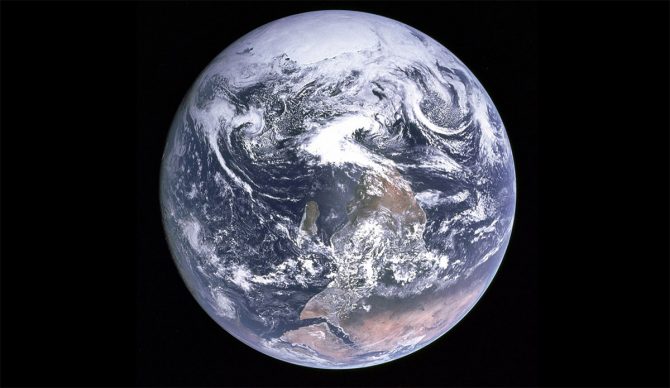
A photo of Earth from Apollo 17 with the south pole at the top and the continent of Africa. Photo: NASA//Wikimedia Commons
Researchers looking at a tiny patch of Pacific Ocean near New Zealand and Australia found something interesting: a new climate pattern that’s being called a “new El Niño.”
El Niño, as you know, is “a warming of the ocean surface, or above-average sea surface temperatures, in the central and eastern tropical Pacific Ocean.”
Typically, low-level surface winds blow from east to west along the equator. In an El Niño year, however, not only do the winds switch direction, but they weaken considerably. It has profound effects on the planet’s weather, including temperature, rainfall, and winds around the world.
The new climate pattern — dubbed rather boringly the “Southern Hemisphere Circumpolar Wavenumber-4 Pattern” instead of the obvious choice of El Hombre — can trigger changes that exert influence over temperatures of the entire Southern Hemisphere.
“This discovery is like finding a new switch in Earth’s climate,” Balaji Senapati, lead author of a study proving the existence of the new climate pattern at the University of Reading, explained. “It shows that a relatively small area of the ocean can have wide-reaching effects on global weather and climate patterns.”
Southern Hemisphere Circumpolar Wavenumber-4 Pattern, unlike El Niño, gets its start in the mid-latitudes. El Niño begins in the tropics. The discovery of the new pattern has climate and weather researchers excited about what it means for the future.
“Understanding this new weather system could greatly improve weather forecasting and climate prediction, especially in the Southern Hemisphere,” Senapati said. “It might help explain climate changes that were previously mysterious and could improve our ability to predict extreme weather and climate events.”
To find the pattern, researchers plugged numbers in to a climate modeling program that simulated 300 years of conditions. Using atmospheric, oceanic, and sea-ice components, they were able to build a relatively accurate representation of the climate system of years gone by. They were then able to pore over the data, which led to the discovery of a pattern of sea surface temperatures that reoccured in the Southern Hemisphere.
“The process starts with heating in the southwestern subtropical Pacific (SWSP), causing atmospheric disturbances,” the researchers wrote. “This leads to an undulation in mid-latitude atmospheric flow…”
As the atmospheric wave makes its way along the ocean, it creates four distinct warmer and cooler areas. Surprisingly, the pattern occurs without the influence of other known weather systems like El Niño or La Niña. The findings also suggest that although we haven’t noticed it until now, it’s been happening for centuries.

